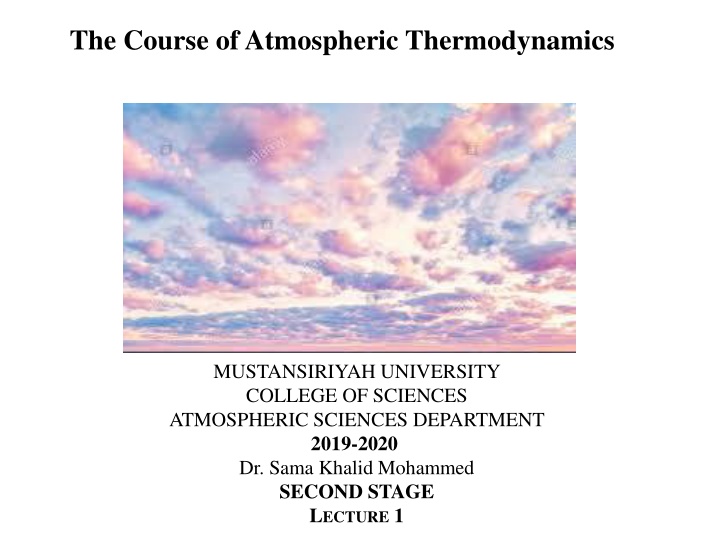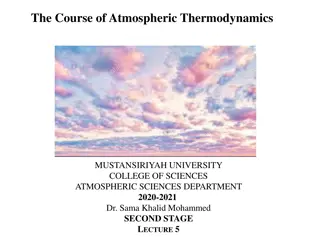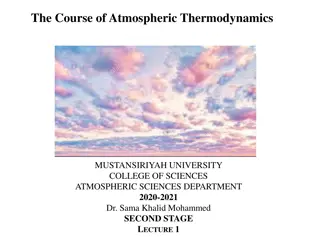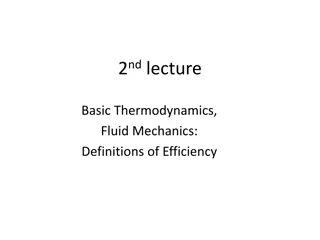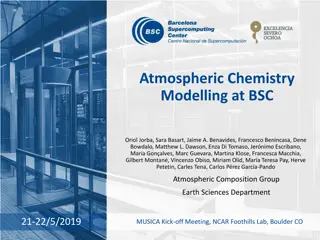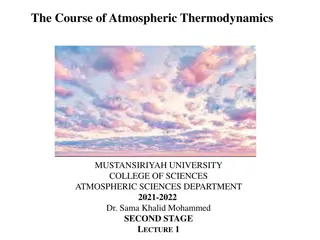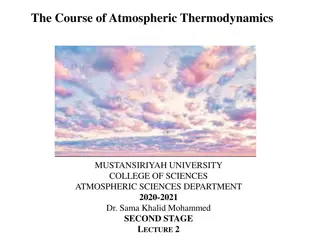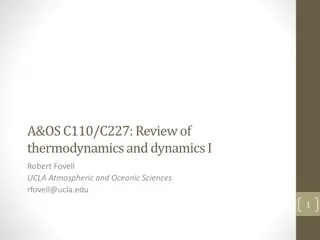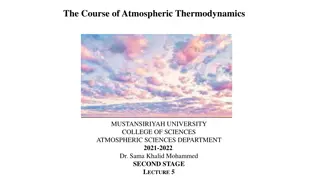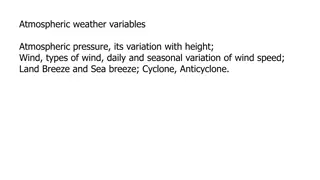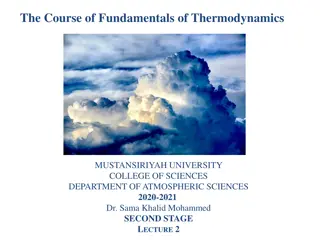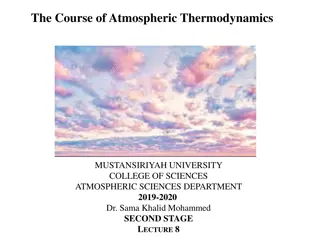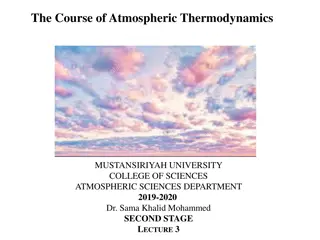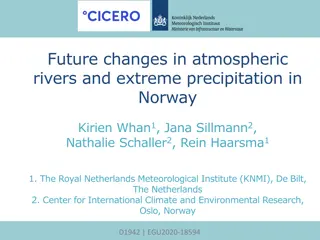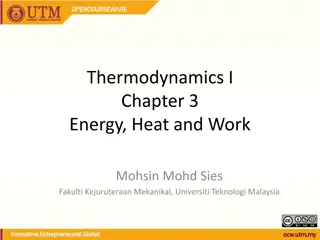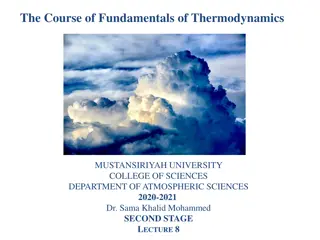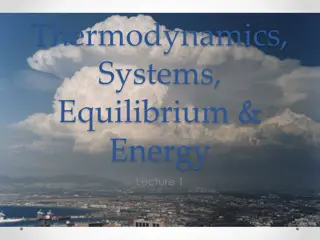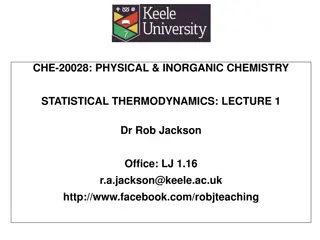Atmospheric Thermodynamics Fundamentals
This lecture covers key concepts in atmospheric thermodynamics, including forms of energy, Earth's atmosphere overview, composition, vertical structure, pressure, temperature, density, and important equations like the hydrostatic and hypsometric equations. Gain insights into the fundamentals of atmospheric science with a focus on energy dynamics and atmospheric properties.
Download Presentation

Please find below an Image/Link to download the presentation.
The content on the website is provided AS IS for your information and personal use only. It may not be sold, licensed, or shared on other websites without obtaining consent from the author.If you encounter any issues during the download, it is possible that the publisher has removed the file from their server.
You are allowed to download the files provided on this website for personal or commercial use, subject to the condition that they are used lawfully. All files are the property of their respective owners.
The content on the website is provided AS IS for your information and personal use only. It may not be sold, licensed, or shared on other websites without obtaining consent from the author.
E N D
Presentation Transcript
The Course of Atmospheric Thermodynamics MUSTANSIRIYAH UNIVERSITY COLLEGE OF SCIENCES ATMOSPHERIC SCIENCES DEPARTMENT 2019-2020 Dr. Sama Khalid Mohammed SECOND STAGE LECTURE 1
This lecture including the following items Recall the forms of energy Overview of the Earth s Atmosphere Composition of the Atmosphere Vertical Structure of the Atmosphere Pressure (hydrostatic eq. ) Temperature Pressure decrease in an isothermal atmosphere Density Geopotential and Geopotential Height Thickness and the hypsometric equation
Overview of the Earths Atmosphere The Atmosphere is really a thin envelope surrounding the earth 99% of atmosphere is in lowest 30 km earth's radius is about 6400 km So, the atmospheric depth is 30 km/6400 km= 0.5% of earth's radius
Composition of the Atmosphere The earth s atmosphere is a thin, gaseous envelope comprised mostly of nitrogen (N2) and oxygen (O2), with small amounts of other gases, such as water vapor (H2O) and carbon dioxide (CO2). Nested in the atmosphere are clouds of liquid water and ice crystals.
Vertical Structure of the Atmosphere Vertical Profile of Pressure Pressure = Force/Area Force is a push or a pull exerted from one object to another Atmospheric Pressure decreases with height.... in a similar manner as density
The Hydrostatic Equation Air pressure at any height in the atmosphere is due to the force per unit area exerted against a surface by the weight of the air molecules above that surface. This weight results from the pull of gravity That explains why pressure decreases with increasing height above the ground P2 P1 > P2 However, pressure gradients cause a force that points from regions with high pressure towards regions with low pressure (vertical Gradient Pressure). P1 That explains why the atmosphere does not collapses on the ground and does not escape to the space
The Hydrostatic Equation Consider g the gravity acceleration (m/s2) Consider that p is negative ( that is, z increases p decreases) Vertical Gradient Acceleration=Force/mass In a hydrostatic equilibrium, and considering the limit as z 0 or: g z pressure p + p pressure p z 1 p= Z Gravity acceleration p = g z Hydrostatic Equation
Vertical Structure of the Atmosphere There are two types of pressure: Hydrostatic pressure, which is just due to the weight of the air above you. Dynamic pressure, which is due to the motion of the air. In meteorology, dynamic pressure is usually very small, and we will assume for now that atmospheric pressure is solely due to hydrostatic pressure. To find how pressure changes with height we start with the hydrostatic equation
Vertical Structure of the Atmosphere This Equation is used to obtain a relationship between pressure and height, used by altimeters to measure pressure and calculate altitude above sea level, in which Aircraft altimeters are essentially barometers that are calibrated to read altitude above mean sea level
Vertical Structure of the Atmosphere Vertical Profile of Temperature There are distinct layers in the atmosphere where the temperature either increases or decreases with height.
Vertical Structure of the Atmosphere Pressure decrease in an isothermal atmosphere Absolute temperature varies by only 20% or so through the troposphere, so we can get an idea how pressure changes with height by assuming a constant temperature (isothermal atmosphere). If this is done, the expression for the pressure profile becomes
Vertical Structure of the Atmosphere Vertical Profile of Density density = mass/volume (grams/m3) so, the density of air is computed by determining the mass of air in a given volume. The density of air decreases with height. Riddles: Why are there more air molecules near the ground than higher in the atmosphere?
Vertical Structure of the Atmosphere Vertical Profile of Density We can also use the hydrostatic equation and the equation of state to find how density changes with height. We first start by differentiating the ideal gas law with respect to height to get
GEOPOTENTIAL (z) The acceleration due to gravity is not constant. It varies from place to place, with the largest variation due to latitude. What we call gravity is the combination of the gravitational acceleration and the centrifugal acceleration from the Earth s rotation. Though small, the variation in gravity must be accounted for. We do this via the concept of geopotential. Geopotential is defined as the potential energy of a unit mass relative to sea level, numerically equal to the work that would be done in lifting the unit mass from sea level to the height at which the mass is located; commonly expressed in terms of dynamic height or geopotential height.
GEOPOTENTIAL (z) A surface of constant geopotential represents a surface along which all objects of the same mass have the same potential energy. If gravity were constant, a geopotential surface would lie at a constant altitude. Since gravity is not constant, a geopotential surface will have varying altitude. The geopotential (z) at height z is thus given by: or zgdz 0 = d gdz ( ) z
Geopotential Height Z The Geopotential height is defined as: ( ) 1 z z = Z gdz g g 0 Where go is the globally averaged acceleration due to gravity at the Earth s surface called standard gravity (~ 9.81m/s2). Geopotential height is expressed in geopotential meters, abbreviated as gpm. Geopotential height is used as the vertical coordinate in most atmospheric applications in which energy plays an important role (e.g., in large-scale atmospheric motions). Values of z (actual height) and Z are almost the same in the lower atmosphere where go ~ g o o Z dz
Geopotential Height Z If the change in gravity with height is ignored, geopotential height and geometric height are related via If the local gravity is stronger than standard gravity, then Z > z. If the local gravity is weaker than standard gravity, then Z < z. Gravity varies, at the North Pole is approximately 9.83 m/s2, while at the Equator it is about 9.78 m/s2. Therefore, g/g0 ~ 1, and for many applications we can ignore the difference between geopotential and geometric height, since Z ~ z. But, keep in mind that they are different, and at times this difference, though small, is very important and cannot be neglected. z(km) Z(km) 0 0 1 1.00 10 9.99 100 98.47 g(ms-2) 9.81 9.80 9.77 9.50
Thickness and the hypsometric equation The hypsometric equation tells us that the thickness between two pressure levels is directly proportional to the average temperature within the layer. We can use thickness as a measure of the average temperature of a layer. We can use contours of thickness in a similar manner to how we use isotherms. Colder layers are thinner, warmer layers are thicker.
Why using hypsometric equation Weather observing stations measure station pressure, which must be converted to sea-level pressure for reporting and plotting on weather charts. The method of calculating the sea-level pressure is called pressure reduction or reducing the pressure to sea-level Sea-level pressure reduction is accomplished via the hypsometric equation, treating Z1 = 0 as sea level, and Z2 = Zsta as the geopotential height of the station. This means p1 = psl, the sea-level pressure, P2 = Psta, the station pressure, and by Rearranging hypsometric equation with these definitions give: There are different formulas used in various applications according to the layer-average temperature in the hypothetical atmospheric layer between the surface and sea level.
